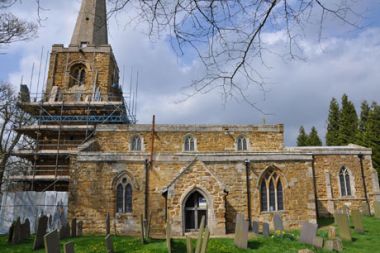Lead theft puts churches in financial difficulty and distracts from mission

Four historic churches around Leicester have become the latest target of roofing lead thieves within the past fortnight, in what appears to be a spike in the crime across the UK in recent weeks.
The churches, some of which date back to the 12th Century, are in the Melton, Market Harborough and Oakham areas and were all raided in six days from Thursday, 4 August.
The latest churches to be targeted are St Mary's in Manton, near Rutland Water; All Saints, in Lubenham, near Market Harborough; St Edmund's, in Egleton, near Rutland Water, and St Mary's at Wyfordby, near Melton.
The Lubenham and Wyfordby churches are in the Diocese of Leicester, while the others are in the Peterborough Diocese.
The thefts come after two men were arrested on suspicion of stealing lead from a church roof in Liverpool. Police were called after two men were spotted on the roof of St James' Church on Mill Lane, West Derby.
And in Birmingham, a 20-year-old man was arrested on 31 July, for stealing lead from the roof of St Mary's Church in Cratfield in December last year.
Following a number of similar thefts across Leicestershire and Rutland in recent years, Leicestershire Police and local church figures urged the public to be on the look-out for suspicious behaviour.
The Archdeacon of Leicester, Tim Stratford said: "I am very sad that once again churches have been targeted by thieves stealing lead from the roof. Despite our best efforts, which include roof alarms, Smartwater, and advice about security awareness, four churches in a relatively small area have lost parts of their roof...This is not a victimless crime. Insurance does not cover the replacement and small, local communities often cannot afford the repairs. We appeal to everyone to be alert for vans parked near churches, frequently looking as though they are working professionally."
Tim Alban-Jones, the Peterborough Diocese Bishop's Chaplain said: "The loss of lead from church roofs is always a major blow to a parish. It has a hugely disproportionate effect on the life of a parish church as the cost of replacing the lead is always far higher than the value of the stolen lead, and it takes time and energy away from the mission of the church."
Meanwhile, in Milngavie in East Dunbartonshire, Scotland, thieves last week targeted St. Paul's Church of Scotland church for the fifth time in recent years. The latest theft follows one in 2012, two in February 2013 and another one in November 2014.
This raises the issue of the rules from Historic England that mean church roofs must be replaced by lead 'like-for-like'. The Church of England said that some churches can appeal against the rules. But critics argue that the rule is counter-productive, leading to repeated thefts from the same church roofs.
A spokesperson for Historic England condemned the thefts but defended the 'like-for-like' rule, telling Christian Today: "The theft of metal from church roofs is an irresponsible and disheartening crime, attacking the spiritual, communal and architectural backbone of our villages, towns and cities. We sympathise with those who look after churches and are faced with such vandalism. There is no question that protecting the church from the elements should be the priority in these situations. There are good reasons why our guidance recommends like-for-like replacement - lead is very durable and performs extremely well as a roofing material. Also, it can easily be repaired and much of it comes from recycled sources."
The Historic England spokesperson emphasised that churches can change to an alternative material for their roofs under certain circumstances. "Our guidance makes it very clear that Historic England will consider supporting the replacement of stolen lead with an alternative material after one incidence of theft if it is satisfied that security measures are unlikely to prevent further attacks, and if the proposed alternative material is suitable in terms of technical performance and appearance," the spokesperson said.
The guidance says: "Every case is assessed on its merits but we appreciate that there will be instances when a change of material will be appropriate. After a theft, in some situations, a durable replacement such as terne coated stainless steel or tiles, might be the most prudent way to repair the building."
A Church of England spokesperson told Christian Today: "The key point is that lead is the best roofing material and replacement is the default, but where there is a great risk of repeated theft, alternatives might be considered."
The Archdeacon of Leicester added: "Whilst there are many roofing materials in use today, lead has an important place in the history of our buildings. For this reason there is an expectation among statutory agencies and planning authorities that historic buildings with lead roofs will be re-roofed with the same material as the need arises. At present this expectation among the regulators of historic buildings prevents the church from replacing lead with similar looking materials less attractive to thieves, such as terne coated steel, unless it can make a special argument on a case-by case basis. This is possible where there have been repeated thefts from a particular building but it is not something that can be agreed for most churches."











